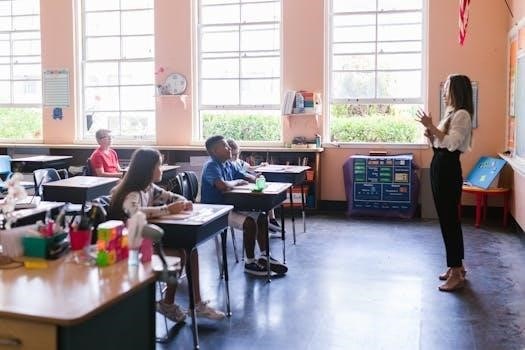small group instruction pdf

small group instruction pdf
Small Group Instruction⁚ A Comprehensive Guide
Small-group instruction is a dynamic approach that allows educators to tailor instruction to meet diverse student needs. It fosters collaboration, encourages active participation, and promotes a deeper understanding of concepts, creating a supportive learning environment.
What is Small Group Instruction?
Small group instruction represents a student-centered teaching method where educators deliver focused lessons to a small cohort of learners. This approach is not a rigid schedule but a strategic tool for differentiating instruction. It allows teachers to target specific skills, provide individualized support, and address diverse learning needs effectively.
Unlike whole-class instruction, small group instruction enables teachers to closely monitor student progress, adjust their teaching style to accommodate different learning preferences, and foster a more interactive learning environment. By working with a smaller number of students, educators can create opportunities for rich discussions, collaborative problem-solving, and peer-to-peer learning. This setting allows for increased student engagement, promotes active participation, and builds social skills.
Moreover, small group instruction is crucial in implementing the science of reading. It is essential to integrate evidence-based instructional techniques to ensure every student accesses grade-level content. This approach supports students identified as needing additional support, providing extra practice, instructional scaffolding, and multisensory instruction to bridge any gaps in understanding.
Benefits of Small Group Instruction
Small group instruction offers numerous advantages that enhance the learning experience for both students and teachers. One of the primary benefits is the ability to provide targeted support. Teachers can identify specific skill gaps and tailor their instruction to address these needs directly. This targeted approach ensures that students receive the focused attention required to master essential concepts.

Another significant benefit is increased student engagement. In a smaller setting, students are more likely to participate actively, ask questions, and share their ideas. This fosters a more interactive and collaborative learning environment, promoting deeper understanding and retention of information. Additionally, small groups provide opportunities for students to learn from each other, building social skills and promoting a sense of community.
Moreover, small group instruction allows teachers to closely monitor student progress and provide timely feedback. This ongoing assessment enables educators to adjust their instruction as needed, ensuring that students stay on track and achieve their learning goals. Furthermore, the personalized attention in small groups can boost student confidence and motivation, leading to improved academic performance.
Finally, teachers can create a supportive and inclusive classroom environment where all students feel valued and empowered to succeed.
Key Elements of Effective Small Group Instruction

Effective small group instruction hinges on several key elements that contribute to a successful and impactful learning experience. First and foremost, careful planning is essential. Teachers must clearly define the learning objectives for each group and select appropriate instructional strategies to achieve those goals. This involves assessing students’ needs, differentiating instruction, and creating engaging activities that cater to various learning styles.
Another crucial element is creating a supportive and inclusive environment. Students should feel comfortable taking risks, asking questions, and sharing their ideas without fear of judgment. Teachers can foster this environment by establishing clear expectations, promoting positive interactions, and encouraging collaboration among group members.
Furthermore, effective small group instruction requires active monitoring and ongoing assessment. Teachers should circulate among the groups, observing student engagement, providing guidance, and collecting data to inform their teaching. This data-driven approach allows educators to adjust their instruction in real-time, ensuring that all students are making progress towards their learning goals.
Finally, thoughtful group composition is essential. Teachers should consider students’ abilities, learning styles, and social dynamics when forming groups, to maximize the potential for collaboration and peer support.
By focusing on these key elements, educators can create meaningful and effective small group learning experiences.
Aligning Small Groups with Learning Goals
Aligning small groups with learning goals is crucial for maximizing the effectiveness of this instructional approach. It ensures that the activities and discussions within each group are directly related to the specific skills and concepts that students need to master.
The first step in this process is to clearly define the learning goals for the lesson or unit. These goals should be specific, measurable, achievable, relevant, and time-bound (SMART). Once the learning goals are established, teachers can then assess students’ needs and group them accordingly. Students who need additional support in a particular area can be placed in a small group that focuses on that specific skill.
When planning activities for each small group, it is essential to ensure that they are aligned with the learning goals. The activities should provide students with opportunities to practice the skills and concepts they need to learn, and they should be designed to challenge students at their appropriate level. For example, if the learning goal is to improve students’ reading comprehension, the small group activities might include reading passages, answering comprehension questions, and discussing the text with their peers.
By aligning small groups with learning goals, teachers can ensure that all students are receiving targeted instruction that meets their individual needs, which ultimately leads to increased student achievement.
Data Collection and Assessment in Small Groups
Data collection and assessment in small groups are essential components of effective instruction. Gathering data during small group sessions allows teachers to monitor student progress, identify areas of difficulty, and adjust instruction to meet individual needs. This formative assessment process provides valuable insights that inform instructional decisions and ensure that students are making adequate progress toward their learning goals.
There are various methods for collecting data in small groups, including observation, anecdotal notes, checklists, and student work samples. Teachers can observe student participation, engagement, and understanding during group discussions and activities. Anecdotal notes can capture specific observations and insights about individual students’ strengths and weaknesses. Checklists can be used to track students’ mastery of specific skills or concepts. Student work samples, such as completed worksheets or written responses, provide tangible evidence of student learning.
The data collected during small group sessions should be used to inform instructional decisions. If students are struggling with a particular concept, the teacher can provide additional support or modify the instruction to better meet their needs. If students are making rapid progress, the teacher can challenge them with more advanced material.
By systematically collecting and analyzing data in small groups, teachers can ensure that all students are receiving the individualized instruction they need to succeed.
Instructional Strategies for Small Groups
Instructional strategies for small groups are diverse and adaptable, designed to maximize student engagement and learning. One effective strategy is the “Think Aloud,” where teachers model their thinking process while reading or problem-solving, making their cognitive strategies visible to students. This helps students understand how to approach complex tasks and develop their own metacognitive skills.
Learning games can also be incorporated to make learning fun and interactive. Games provide opportunities for students to practice skills and concepts in a low-stakes environment, promoting collaboration and friendly competition. Graphic organizers are another valuable tool for helping students organize their thoughts, visualize relationships between ideas, and improve comprehension.
Writing conferences offer individualized support for students’ writing development. Teachers can provide feedback on specific aspects of their writing, such as organization, clarity, and grammar, helping them refine their skills and improve their overall writing quality. Book clubs encourage students to engage in meaningful discussions about literature, fostering critical thinking and communication skills.
The Gradual Release of Responsibility model, often referred to as “I do, we do, you do,” can be effectively implemented in small groups. Teachers begin with direct instruction and modeling, then transition to guided practice in small groups, and finally, independent practice. This scaffolded approach allows students to gradually take ownership of their learning and develop mastery of the skills.
Think Alouds in Small Group Reading Instruction
Think alouds are a powerful strategy in small group reading instruction, providing students with a window into the thought processes of proficient readers. During a think aloud, the teacher verbalizes their thoughts while reading a text, demonstrating how they make predictions, ask questions, clarify confusion, and make connections to their own experiences. This explicit modeling helps students develop their own comprehension strategies and become more active and engaged readers.
To implement think alouds effectively, the teacher selects a short passage of text that is appropriate for the students’ reading level and contains opportunities for modeling various comprehension strategies. As the teacher reads, they pause periodically to share their thoughts, using phrases such as, “I wonder why…” or “This reminds me of…” or “I don’t understand this part, so I’m going to reread it.”
The teacher also models how to use context clues to figure out the meaning of unfamiliar words, how to make inferences based on the text, and how to summarize the main ideas. By making their thinking visible, the teacher empowers students to develop their own metacognitive awareness and become more strategic readers.
Think alouds can be particularly beneficial for struggling readers who may not be aware of the strategies that proficient readers use automatically. By providing explicit instruction and modeling, think alouds help these students develop the skills and confidence they need to become successful readers.
Differentiated Instruction Strategies in Small Groups
Differentiated instruction in small groups is a powerful approach to meet the diverse learning needs of all students. It involves tailoring instruction to address individual differences in readiness, interest, and learning profile. By providing targeted support and challenges, differentiated instruction ensures that every student can access the curriculum and achieve success.
One key strategy is to group students based on their skill level or learning needs. This allows the teacher to provide focused instruction on specific concepts or skills that students are struggling with. For example, students who need extra support with phonics can participate in a small group that focuses on phonemic awareness and decoding skills.
Another strategy is to provide different levels of support and scaffolding. This can include providing graphic organizers, sentence starters, or modified texts; For students who are ready for a challenge, the teacher can provide more complex texts or tasks that require higher-level thinking skills.
It’s also important to consider students’ interests and learning styles when planning differentiated instruction. The teacher can provide choices in activities or projects that allow students to explore topics that are relevant to their lives.
By implementing differentiated instruction strategies in small groups, teachers can create a more equitable and engaging learning environment where all students can thrive.
Managing Small Group Work for Justice and Engagement

Managing small group work effectively is crucial for fostering justice and engagement in the classroom. It’s about creating an environment where all students feel valued, respected, and empowered to participate actively in their learning. This involves careful planning, thoughtful group formation, and clear expectations for collaboration and accountability.
One key aspect of managing small group work for justice is to ensure that groups are diverse and inclusive. This means considering factors such as race, ethnicity, gender, language, and ability when forming groups. Diverse groups provide students with opportunities to learn from each other’s perspectives and experiences, promoting empathy and understanding.
It’s also important to establish clear norms and expectations for group work. These norms should emphasize respect, active listening, and shared responsibility. Students should be taught how to effectively communicate, resolve conflicts, and support each other’s learning.
To promote engagement, the tasks assigned to small groups should be meaningful, challenging, and relevant to students’ lives. Students should have opportunities to make choices and take ownership of their learning. The teacher should also provide regular feedback and support, helping students to stay on track and celebrate their successes.
By managing small group work with a focus on justice and engagement, teachers can create a more equitable and empowering learning environment for all students.
Integrating Science of Reading in Small Group Instruction
Integrating the Science of Reading (SOR) into small group instruction is essential for effective literacy development. SOR emphasizes evidence-based practices that align with how the brain learns to read. By incorporating these principles, teachers can provide targeted support to students in small groups, addressing their specific reading needs.
One key aspect of SOR is phonological awareness, the ability to recognize and manipulate the sounds in spoken language. In small group instruction, teachers can use activities such as phoneme blending, segmenting, and deleting to strengthen students’ phonological awareness skills.
Another important element of SOR is phonics, the relationship between letters and sounds. Small group instruction provides an ideal setting for explicit and systematic phonics instruction. Teachers can use decodable texts and targeted activities to help students learn and apply phonics rules.
Fluency is also a critical component of reading. In small group instruction, teachers can use repeated reading and other fluency-building activities to help students read accurately, quickly, and with expression.
Vocabulary development is another essential aspect of SOR. Small group instruction provides opportunities for teachers to introduce new vocabulary words, discuss their meanings, and provide students with multiple exposures to the words in different contexts.

By integrating the Science of Reading into small group instruction, teachers can provide targeted and effective support to students, helping them to become proficient readers.